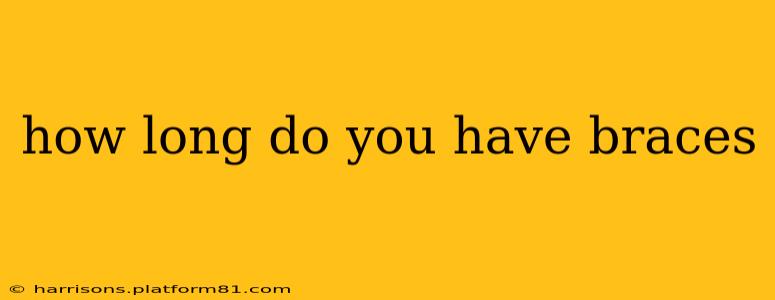How Long Do You Have Braces? The Timeline of Orthodontic Treatment
The question "How long do you have braces?" doesn't have a single, simple answer. The duration of orthodontic treatment with braces varies significantly depending on several factors. Understanding these factors will help you manage expectations and work collaboratively with your orthodontist to achieve the best possible results.
What Factors Determine Braces Treatment Time?
Several key factors influence how long you'll need braces:
-
Severity of the misalignment: Minor crowding or spacing issues may only require a few months of treatment, while severe malocclusion (bad bite) requiring significant jaw realignment could take two or more years. The more complex the problem, the longer the treatment.
-
Type of braces: Traditional metal braces generally take a similar amount of time as other types like ceramic or lingual braces. However, newer technologies might offer slightly faster treatment times. Your orthodontist will discuss the best option for your specific needs.
-
Patient cooperation: Wearing your braces as instructed and diligently following your orthodontist's recommendations for home care is crucial. Missing appointments, neglecting oral hygiene, or not wearing elastics (rubber bands) as prescribed can significantly prolong treatment.
-
Growth and development: For younger patients still growing, the treatment timeline might be longer as the orthodontist needs to monitor and accommodate jaw development.
-
Underlying medical conditions: Certain medical conditions can affect bone growth and healing, potentially influencing the overall treatment duration. Always inform your orthodontist about any health issues.
How Long is Typical?
While the duration varies, a typical range for braces treatment is 18 to 30 months (1.5 to 2.5 years). However, it's essential to remember that this is just an average. Some patients may require shorter treatment, while others may need longer.
What About Invisalign?
Invisalign aligners are an alternative to traditional braces. While Invisalign treatment plans are individualized, the treatment time is generally comparable to that of braces. The overall timeline depends on the complexity of the case and patient compliance.
How Can I Shorten My Braces Treatment Time?
While you can't magically reduce the treatment time, you can significantly contribute to a more efficient process by:
- Maintaining excellent oral hygiene: Brush and floss diligently as instructed to prevent cavities and gum disease, which can complicate treatment.
- Attending all scheduled appointments: Regular checkups allow your orthodontist to monitor progress and make necessary adjustments.
- Wearing elastics or other appliances consistently: Following your orthodontist's instructions regarding additional devices is crucial for achieving the desired results.
- Communicating openly with your orthodontist: Report any discomfort, issues with the appliances, or changes in your oral health promptly.
What Happens After Braces Are Removed?
After braces are removed, a retainer is essential to maintain the new alignment. Your orthodontist will provide instructions on wearing the retainer to prevent teeth from shifting back to their original positions. The retainer phase is an integral part of the overall orthodontic treatment, and adherence to the instructions is crucial for long-term success.
Ultimately, the best way to know how long you will need braces is to consult with a qualified orthodontist. They will assess your specific situation, explain the treatment plan, and provide a realistic timeline based on your individual needs. Open communication with your orthodontist is key to a successful and timely orthodontic journey.
